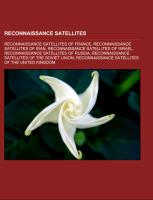- Start
- Reconnaissance satellites
Reconnaissance satellites
Angebote / Angebote:
Source: Wikipedia. Pages: 54. Chapters: Reconnaissance satellites of France, Reconnaissance satellites of Iran, Reconnaissance satellites of Israel, Reconnaissance satellites of Russia, Reconnaissance satellites of the Soviet Union, Reconnaissance satellites of the United Kingdom, Reconnaissance satellites of the United States, Spy satellite, Corona, KH-11 Kennan, KH-9 Hexagon, KH-7 Gambit, KH-8 GAMBIT, Missile Defense Alarm System, Manned Orbiting Laboratory, TKS, TacSat-3, TecSAR, Zenit, Space-Based Infrared System, Vela, Resurs DK, Solrad 10, Samos, Defense Support Program, Almaz, Kosmos, Space-based radar, Solrad 8, Yaogan, Fanhui Shi Weixing, Information Gathering Satellite, Ofeq, Solrad 3, Solrad 6, Kosmos 1818, Solrad 9, Enhanced Imaging System, Oko, RISAT-2, RORSAT, Naval Ocean Surveillance System, Kosmos 1867, KH-5 Argon, SAR-Lupe, Solrad 5B, Arirang-2, Galactic Radiation and Background, Kosmos 954, Mentor, Misty, US-KMO, MiTEx, Trumpet, Samos-F, WorldView-1, Sina-1, Persona, Magnum, Zircon, Space Based Space Surveillance, Yantar, WorldView-2, Canyon, Discoverer 1, KH-6 Lanyard, Ofek-9, FORTE, Monitor-E, SPRN-2 Prognoz, Mercury, SkyGrabber, Intruder, Kosmos 1402, Spatial reconnaissance, Orlets-1, Hélios 1B, Helios 2, Ofek-7, Discoverer 14, SLDCOM. Excerpt: The Corona program was a series of American strategic reconnaissance satellites produced and operated by the Central Intelligence Agency Directorate of Science & Technology with substantial assistance from the U.S. Air Force. The Corona satellites were used for photographic surveillance of the Soviet Union (USSR), the People's Republic of China, and other areas beginning in June 1959 and ending in May 1972. The name of this program is sometimes seen as "CORONA", but its actual name "Corona" was a codeword, not an acronym for anything. The Corona project was pushed forward especially following the shooting down of a U-2 spy plane over the Soviet Union in May 1960. The Corona satellites were designated KH-1, KH-2, KH-3, KH-4, KH-4A and KH-4B. KH stood for "Key Hole" or "Keyhole" (Code number 1010), and the incrementing number indicated changes in the surveillance instrumentation, such as the change from single-panoramic to double-panoramic cameras. The "KH" naming system was first used in 1962 with KH-4 and the earlier numbers were retroactively applied. There were 144 Corona satellites launched, of which 102 returned usable photographs. Diagram of "J-1" type stereo / panoramic constantly rotating Corona reconnaissance satellite camera system used on KH-4A missions from 1963 to 1969.The Corona satellites used 31, 500 feet (9, 600 meters) of special 70 millimeter film with 24 inch (60 centimeter) focal length cameras. Initially orbiting at altitudes from 165 to 460 kilometers above the surface of the Earth, the cameras could resolve images on the ground down to 7.5 meters in diameter. The two KH-4 systems improved this resolution to 2.75 meters and 1.8 meters respectively, because they operated at lower orbital altitudes. The code name "Corona" was more fitting than its originators had ever imagined. The initial missions of the program suffered from many technical problems, among them, mysterious fogging and bright streaks that were seen on the returned film of some miss
Folgt in ca. 5 Arbeitstagen
